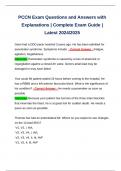PCCN Exam Questions and Answers with
Explanations | Complete Exam Guide |
Latest 2024/2025
Gene had a DDD pacer inserted 3 years ago. He has been admitted for
pacemaker syndrome. Symptoms include: - Correct Answer - Fatigue,
agitation, forgetfulness
Rationale: Pacemaker syndrome is caused by a loss of atrial kick or
regurgitation against a closed AV valve. Gene's atrial lead may be
damaged or may have failed.
Your acute MI patient waited 16 hours before coming to the hospital. He
has a RBBB and a left anterior fascicular block. What is the significance of
his condition? - Correct Answer - He needs a pacemaker as soon as
possible
Rationale: Because your patient has lost two of the three main fascicles
that innervate the heart, he is at great risk for sudden death. He needs a
pacer as soon as possible.
Thomas has had an anterolateral MI. Where so you expect to see changes
on the 12-lead EKG?
-V1, V2, I, AVL
-V2, V3, V4, I, AVL
-V2, V3, V4, II, III, AVF
-V1, V2, II, III, AVF
,- Correct Answer - V2, V3, V4, I, AVL
Rationale: Changes in V2, V3, V4, I and AVL indicate an anterolateral MI.
The MI could also be detected in V5 and V6 which are also lateral leads.
What do abnormal Q waves signify on a 12-lead EKG?
- Correct Answer - Complete- thickness infarction of the myocardium
Rationale: When tissue dies as a result of MI, it becomes electrically dead,
causing the opposing energy to become the dominant feature.
Partial- thickness myocardial death would be classified as a non-Q wave
MI.
Which parameter is measured by the vertical lines on the EKG paper?
-Velocity
-Time
-Voltage
-Intensity
- Correct Answer - Time
Rationale: The vertical lines on the EKG graph paper represent time. When
conduction defects occur, the tracings are wider because it takes more time
to travel the same distance.
Which parameter is measured by the horizontal lines on the EKG paper?
-Velocity
-Time
-Voltage
-Intensity
- Correct Answer - Voltage
,Rationale: Voltage is measured by the horizontal lines on the EKG graph
paper. If a ventricle is enlarged, a larger voltage will be apparent on the 12-
lead EKG
V1 and V2 show which type of bundle branch block?
- Correct Answer - Right
V1 and V2 show RBBBs
Which conditions are associated with ST/T wave abnormalities?
- Correct Answer - Ventricular hypertrophy, pericarditis, COPD
What are some common reasons for pacemaker insertion?
- Correct Answer - Symptomatic bradycardia, overdrive pacing, acute MI
with sinus dysfunction
Rationale: There are multiple reasons for pacemaker insertion -- for
example symptomatic bradycardia, bradycardia with escape beats,
overdrive pacing, bradycardia/ arrest, acute MI with sinus dysfunction, 2nd
heart block type 2 (Mobitz type 2), complete heart block (3rd degree heart
block), and development of a new bundle branch block.
Quinidine and hypomagnesemia can both lead to which condition?
- Correct Answer - Torsades de Pointes
Rationale: Quinindine and hypomagnesemia can lead to Torsades de
Pointes -- a recurrent ventricular tachycardia that turns on its axis every 6
to 8 beats, giving the EKG a twisting or "turning on point" look.
, Hypomagnesemia can occur when the patient recieves TPN (total parental
nutrition).
Which condition is required for a diagnosis of HAP (hospital acquired
pneumonia)?
- Correct Answer - Hospitalization for more than 2 days
Rationale: Hospitalization for more than 2 days is required for a diagnosis
of hospital acquired PNA. If PNA occurs prior to 2 days' stay in the hospital,
the infection is considered to be a community-acquired PNA. HAP is
especially dangerous in a cardiac patient, but can be prevented most of the
time via handwashing and aseptic technique.
What is the most common causative organism in HAP (hospital acquired
PNA)?
- Correct Answer - Pseudomonas aeruginosa
Rationale: Pseudomonas aeruginosa is the organism most commonly
implicated in HAP.
MRSA is the second most common cause of HAP.
Cardiac patients are usually already quite compromised and susceptible to
these organisms.
What are some risk factors for developing HAP (hospital acquired PNA)?
- Correct Answer - H2 blockers, age, history of smoking
Rationale: Factors associated with higher risk of HAP include altered level
of consciousness, placement of NG tube, the elderly, COPD, postoperative
patients, use of H2 blockers, antacids, periodontal work, and acute illness
or injury.




